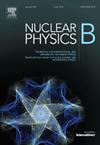New constraints on singlet scalar dark matter model with LZ, invisible Higgs decay and gamma-ray line observations
IF 2.5
3区 物理与天体物理
Q2 PHYSICS, PARTICLES & FIELDS
引用次数: 0
Abstract
The singlet scalar dark matter (DM) model is a minimal extension of the Standard Model (SM). This model features only two free parameters: the singlet scalar mass and the quartic coupling between the singlet scalar and the SM Higgs doublet. Previous studies have suggested that only the resonant region remains viable under combined constraints. In this work, we revisit and refine the constraints using data from the direct detection experiment LUX-ZEPLIN(LZ), invisible Higgs decay measurements, and gamma-ray line observations conducted by Fermi-LAT and DAMPE. Our findings indicate that the latest results from LZ have significantly strengthened the constraints on the model parameters. We demonstrate that only a narrow parameter region remains viable, specifically and . This suggests that a three-fold improvement in the current LZ results would thoroughly examine the parameter space below for the singlet scalar DM model.
单重态标量暗物质模型与LZ、不可见希格斯衰变和伽玛射线线观测的新约束
单重态标量暗物质(DM)模型是标准模型(SM)的最小扩展。该模型只有两个自由参数:单重态标量质量mS和单重态标量与SM希格斯双重态之间的四次耦合a2。先前的研究表明,在综合约束下,只有共振区域仍然可行。在这项工作中,我们使用直接探测实验LUX-ZEPLIN(LZ)的数据,不可见的希格斯衰变测量以及费米- lat和DAMPE进行的伽马射线线观测来重新审视和完善约束。我们的研究结果表明,LZ的最新结果显著加强了对模型参数的约束。我们证明只有一个狭窄的参数区域是可行的,特别是60.5GeV<mS<;62.5GeV和1.7×10−4<a2<4.7×10−4。这表明,当前LZ结果的三倍改进将彻底检查单重态标量DM模型低于1TeV的参数空间。
本文章由计算机程序翻译,如有差异,请以英文原文为准。
求助全文
约1分钟内获得全文
求助全文
来源期刊

Nuclear Physics B
物理-物理:粒子与场物理
CiteScore
5.50
自引率
7.10%
发文量
302
审稿时长
1 months
期刊介绍:
Nuclear Physics B focuses on the domain of high energy physics, quantum field theory, statistical systems, and mathematical physics, and includes four main sections: high energy physics - phenomenology, high energy physics - theory, high energy physics - experiment, and quantum field theory, statistical systems, and mathematical physics. The emphasis is on original research papers (Frontiers Articles or Full Length Articles), but Review Articles are also welcome.
 求助内容:
求助内容: 应助结果提醒方式:
应助结果提醒方式:


